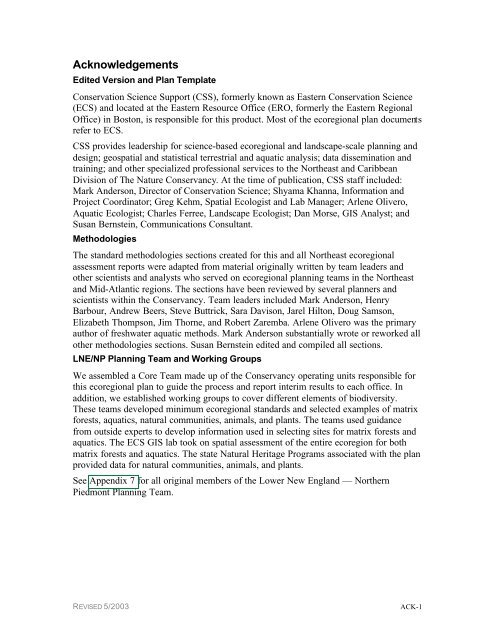Full ecoregional plan - Conservation Gateway
Full ecoregional plan - Conservation Gateway
Full ecoregional plan - Conservation Gateway
- No tags were found...
Create successful ePaper yourself
Turn your PDF publications into a flip-book with our unique Google optimized e-Paper software.
AcknowledgementsEdited Version and Plan Template<strong>Conservation</strong> Science Support (CSS), formerly known as Eastern <strong>Conservation</strong> Science(ECS) and located at the Eastern Resource Office (ERO, formerly the Eastern RegionalOffice) in Boston, is responsible for this product. Most of the <strong>ecoregional</strong> <strong>plan</strong> documentsrefer to ECS.CSS provides leadership for science-based <strong>ecoregional</strong> and landscape-scale <strong>plan</strong>ning anddesign; geospatial and statistical terrestrial and aquatic analysis; data dissemination andtraining; and other specialized professional services to the Northeast and CaribbeanDivision of The Nature Conservancy. At the time of publication, CSS staff included:Mark Anderson, Director of <strong>Conservation</strong> Science; Shyama Khanna, Information andProject Coordinator; Greg Kehm, Spatial Ecologist and Lab Manager; Arlene Olivero,Aquatic Ecologist; Charles Ferree, Landscape Ecologist; Dan Morse, GIS Analyst; andSusan Bernstein, Communications Consultant.MethodologiesThe standard methodologies sections created for this and all Northeast <strong>ecoregional</strong>assessment reports were adapted from material originally written by team leaders andother scientists and analysts who served on <strong>ecoregional</strong> <strong>plan</strong>ning teams in the Northeastand Mid-Atlantic regions. The sections have been reviewed by several <strong>plan</strong>ners andscientists within the Conservancy. Team leaders included Mark Anderson, HenryBarbour, Andrew Beers, Steve Buttrick, Sara Davison, Jarel Hilton, Doug Samson,Elizabeth Thompson, Jim Thorne, and Robert Zaremba. Arlene Olivero was the primaryauthor of freshwater aquatic methods. Mark Anderson substantially wrote or reworked allother methodologies sections. Susan Bernstein edited and compiled all sections.LNE/NP Planning Team and Working GroupsWe assembled a Core Team made up of the Conservancy operating units responsible forthis <strong>ecoregional</strong> <strong>plan</strong> to guide the process and report interim results to each office. Inaddition, we established working groups to cover different elements of biodiversity.These teams developed minimum <strong>ecoregional</strong> standards and selected examples of matrixforests, aquatics, natural communities, animals, and <strong>plan</strong>ts. The teams used guidancefrom outside experts to develop information used in selecting sites for matrix forests andaquatics. The ECS GIS lab took on spatial assessment of the entire ecoregion for bothmatrix forests and aquatics. The state Natural Heritage Programs associated with the <strong>plan</strong>provided data for natural communities, animals, and <strong>plan</strong>ts.See Appendix 7 for all original members of the Lower New England — NorthernPiedmont Planning Team.REVISED 5/2003ACK-1
















